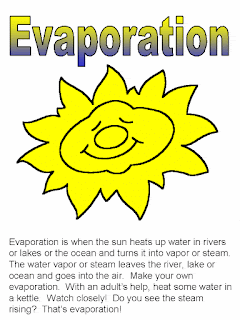Water Cycle
The cycle of processes by which water circulates between the earth's oceans, atmosphere, and land, involving precipitation as rain and snow, drainage in streams and rivers, and return to the atmosphere by evaporation and transpiration.
The water cycle describes the existence and movement of water on, in, and above the Earth. Earth's water is always in movement and is always changing states, from liquid to vapor to ice and back again. The water cycle has been working for billions of years and all life on Earth depends on it continuing to work; the Earth would be a pretty stale place without it.
The cycle of processes by which water circulates between the earth's oceans, atmosphere, and land, involving precipitation as rain and snow, drainage in streams and rivers, and return to the atmosphere by evaporation and transpiration.
The water cycle describes the existence and movement of water on, in, and above the Earth. Earth's water is always in movement and is always changing states, from liquid to vapor to ice and back again. The water cycle has been working for billions of years and all life on Earth depends on it continuing to work; the Earth would be a pretty stale place without it.
This cycle is made up of a few main parts:
- evaporation (and transpiration)
- condensation
- precipitation
- collection
Evaporation:
Evaporation is when the sun heats up water in rivers or lakes or the ocean and turns it into vapor or steam. The water vapor or steam leaves the river, lake or ocean and goes into the air.
Transpiration is the process by which plants lose water out of their leaves. Transpiration gives evaporation a bit of a hand in getting the water vapor back up into the air.
Condensation:
Water vapor in the air gets cold and changes back into liquid, forming clouds. This is called condensation.
You can see the same sort of thing at home... Pour a glass of cold water on a hot day and watch what happens. Water forms on the outside of the glass. That water didn't somehow leak through the glass! It actually came from the air. Water vapor in the warm air, turns back into liquid when it touches the cold glass.
Precipitation:
Precipitation occurs when so much water has condensed that the air cannot hold it anymore. The clouds get heavy andwater falls back to the earth in the form of rain, hail, sleet or snowstarts
Collection:
When water falls back to earth as precipitation, it may fall back in the oceans, lakes or rivers or it may end up on land. When it ends up on land, it will either soak into the earth and become part of the “ground water” that plants and animals use to drink or it may run over the soil and collect in the oceans, lakes or rivers where the cycle starts
One single detailed diagram of water cycle.






very informative and interesting..
ReplyDeletekeep it up.. 👍👍🍑😉
Thank u so much :)
Deletethe pleasure is all mine 🍑
Deletethe pleasure is all mine 🍑
Deletevery informative and interesting..
ReplyDeletekeep it up.. 👍👍🍑😉